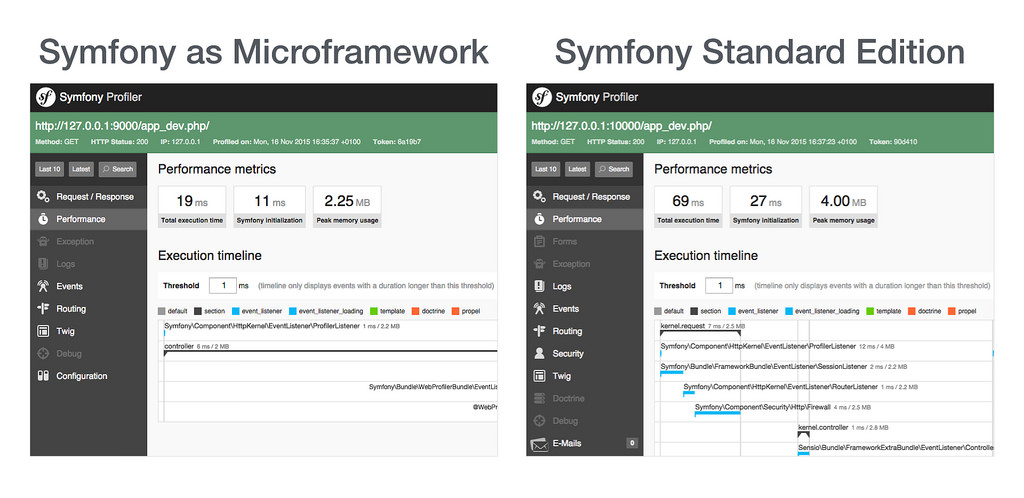Symfony2 太“重”了?试试 Symfony2 微框架
Symfony2 是一个全功能的框架,因此有些开发人员会以它太“重”了(而不是太“难”了)为理由而拒绝使用。在开发环境下,一个简单的Symfony页面大概需要花费 70ms,而prod环境下大概需要30ms(以上是个人在一个Web App上实践后数据)。虽然相对其提供的功能而言,这是一个可观的数据,但对于一个简单的REST API请求而言,这也许真的太“重”了。
Symfony 2.8 引入了微内核的功能,用来创建简单,甚至是单文件的Symfony 应用。
下面是一个简单的例子:
// app/MicroKernel.php
use Symfony\Bundle\FrameworkBundle\Kernel\MicroKernelTrait;
use Symfony\Component\Config\Loader\LoaderInterface;
use Symfony\Component\DependencyInjection\ContainerBuilder;
use Symfony\Component\HttpFoundation\Response;
use Symfony\Component\HttpKernel\Kernel;
use Symfony\Component\Routing\RouteCollectionBuilder;
class MicroKernel extends Kernel
{
use MicroKernelTrait;
public function registerBundles()
{
return array(new Symfony\Bundle\FrameworkBundle\FrameworkBundle());
}
protected function configureRoutes(RouteCollectionBuilder $routes)
{
$routes->add('/', 'kernel:indexAction', 'index');
}
protected function configureContainer(ContainerBuilder $c, LoaderInterface $loader)
{
$c->loadFromExtension('framework', ['secret' => '12345']);
}
public function indexAction()
{
return new Response('Hello World');
}
}
MicroKernel类主要实现配置 bundle、配置路由、路由响应的功能;只需要简单几行代码就完成一个Symfony应用。当然,MicroKernel实际上不会提升Symfony的运行性能,它只不过是改变了Symfony配置路由与bundle的方式,但是这样的改变使得你的应用只使用Symfony最基本的功能,禁用了大量的特性,因此可以带来性能的提升:

显然,这样做带来一个非常大的灵活性,你可以在Symfony的基础上开发你的应用,避免通常微框架所带来的限制,当你的应用越来越复杂的时候,你可以逐渐的将需要用到的Symfony特性加进去。
譬如,下面的例子就是在上面的基础上添加了Twig模板、Web调试工具栏的支持,依然可以写在一个文件里。
// app/MicroKernel.php
class MicroKernel extends Kernel
{
use MicroKernelTrait;
public function registerBundles()
{
$bundles = array(
new Symfony\Bundle\FrameworkBundle\FrameworkBundle(),
new Symfony\Bundle\TwigBundle\TwigBundle(),
);
if (in_array($this->getEnvironment(), array('dev', 'test'), true)) {
$bundles[] = new Symfony\Bundle\WebProfilerBundle\WebProfilerBundle();
}
return $bundles;
}
protected function configureRoutes(RouteCollectionBuilder $routes)
{
$routes->mount('/_wdt', $routes->import('@WebProfilerBundle/Resources/config/routing/wdt.xml'));
$routes->mount('/_profiler', $routes->import('@WebProfilerBundle/Resources/config/routing/profiler.xml'));
$routes->add('/', 'kernel:indexAction', 'index');
}
protected function configureContainer(ContainerBuilder $c, LoaderInterface $loader)
{
// load bundles' configuration
$c->loadFromExtension('framework', [
'secret' => '12345',
'profiler' => null,
'templating' => ['engines' => ['twig']],
]);
$c->loadFromExtension('web_profiler', ['toolbar' => true]);
// add configuration parameters
$c->setParameter('mail_sender', '[email protected]');
// register services
$c->register('app.markdown', 'AppBundle\\Service\\Parser\\Markdown');
}
public function indexAction()
{
return $this->container->get('templating')->renderResponse('index.html.twig');
}
}
单文件应用可能会导致代码显得混乱,下面是一个可以在真实场景中使用的例子,包括单个service.yml、config.yml配置,路由使用 annotations 注释:
// app/MicroKernel.php
// ...
class MicroKernel extends Kernel
{
use MicroKernelTrait;
public function registerBundles()
{
return array(
new Sensio\Bundle\FrameworkExtraBundle\SensioFrameworkExtraBundle(),
new Symfony\Bundle\FrameworkBundle\FrameworkBundle(),
new Symfony\Bundle\TwigBundle\TwigBundle(),
new AppBundle\AppBundle(),
);
}
protected function configureRoutes(RouteCollectionBuilder $routes)
{
$routes->mount('/', $routes->import('@AppBundle/Controller', 'annotation'));
}
protected function configureContainer(ContainerBuilder $c, LoaderInterface $loader)
{
$loader->load(__DIR__.'/config/config_'.$this->getEnvironment().'.yml');
$loader->load(__DIR__.'/config/services.yml');
}
}
当然,不要忘记在入口文件中使用MicroKernel :)
// web/app.php
use Symfony\Component\HttpFoundation\Request;
$loader = require __DIR__.'/../app/autoload.php';
require_once __DIR__.'/../app/MicroKernel.php';
$app = new MicroKernel('prod', false);
$app->loadClassCache();
$app->handle(Request::createFromGlobals())->send();
Symfony2引入微内核,还会带来另外一个便利,通常,对于后台、内容编辑、内容提交的页面,我们需要全功能的支持,然而对于一些只需要简单的JSON API接口,我们可以添加多一个使用微内核的入口文件,提高接口的响应速度,减少资源消耗。